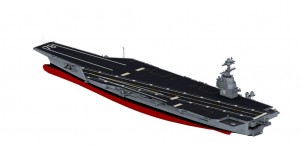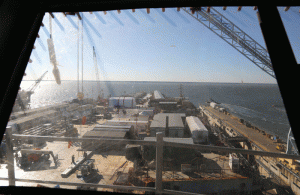2015-01-22 When visiting the Gerald R. Ford and making the trek to the bridge, one notices quickly that the deck space in front of the island is significantly expanded over a Nimitz class carrier.
We talked with the Captain and a construction engineer about the changes on our visit to the ship at Newport News on January 9, 2015.
The key point was that with the island moved back further on the flight deck and with one less aircraft elevator, the Gerald R. Ford ends up with an additional 8000 square feet of operational space on the flight deck.
The operational tempo is facilitated as well by the new weapons loading systems with the weapons coming to the flight deck fully assembled and ready for loading.

The Captain highlighted that the approach was to end up with something similar to the NASCAR pit stop approach aboard the deck where the planes are prepared to launch with weaponization on the deck more rapidly than on the Nimitz class carrier.
In other words, the additional real estate is being worked with a shift in the concepts of operations whereby the strike fleet can be launched with more effective weaponization support.
And with the Electro-Magnetic Launch System (EMALS) and the Advanced Arresting Gear (AAG), the flight deck can expand the range of aircraft managed on the flight deck as well.
The shift from steam and hydraulics to electro-magnetic pulse and the implementation of an advanced arresting gear is designed to enable a long-term transformation of the embarked airwing.
As the Captain put it:
With EMALS and AAG you do not launch aircraft any faster. You cannot really recover aircraft any faster. You are still limited to about a 45 second interval between aircraft.
But what they do facilitate is an expansion of the operational capability of landing aircraft.
You can work with lighter or heavier aircraft and perhaps lower the wind requirements for take off and landing and provide a means for the aircraft to prolong service life by reducing wear and tear on landing and take off.
And most importantly, the combination of the new systems will allows us to get a weaponized aircraft off of the deck faster.

Another aspect of change comes from the refueling station changes.
According to the Captain:
In flight deck refueling on the Nimitz class, everything comes from outside.
We run hoses all the way across to the different areas and you cannot taxi over the hoses when they are full of fuel.
We have gotten rid of these choke points by building in pit stop deck refueling stations.
Editor’s Note: According to a November 9, 2013 article on Defense Update:
The US Navy required the carrier to support higher sortie rate of around 160 exits a day with surges to a maximum of 220 sorties a day in times of crisis and intense air warfare activity.
To support the increased rate, more flight deck was cleared by reducing the number of lifts to three, and using a shorter but taller island (it stands 20 feet [six meter] taller than previous aircraft carriers’ islands.)
The island is positioned 140 feet further aft and three feet further outboard than the island of the Nimitz’s class, thus clearing more deck area for aircraft operations and support.
The route of weapons to the aircraft stops on the flight deck has been replanned to accommodate higher re-arming rates, and in turn higher potential sortie rates.
Moving the island creates deck space for a centralized re-arming and re-fueling location.
The new path that ordnance follows does not cross any areas of aircraft movement, thereby reducing traffic problems in the hangars and on the flight deck. This reduces the number of times that an aircraft will have to be moved after landing before it can be launched again.
Fewer aircraft movements require, in turn, fewer deck hands to accomplish them, reducing the size of the ship’s crew. The ship is designed to require 800 fewer sailors to operate, and for 400 fewer personnel to embark with an air wing on the ship, in total, around 4,300 hands, compared to the average 5,500 hands operating a Nimitz class carrier.
The flight deck of CVN 78 has been completely redesigned and rearranged. The end result is a 25 percent increase in the ability to launch and recover aircraft missions. In order to accomplish this, the carrier has three aircraft elevators instead of four, and the island is positioned 140 feet (42.6 m’) further aft.
The flow of weapons has been significantly upgraded, with the installation of new electromagnetic hoist system replacing cables.
Also see the following earlier stories:
https://sldinfo.com/shaping-flexible-c2-at-sea-the-role-of-flexible-infrastructure/
https://sldinfo.com/the-second-line-of-defense-visit-to-the-uss-gerald-ford/

